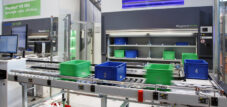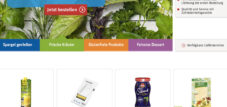Grocery online shops – Success starts with storage
Language selection 📢
Published on: July 13, 2016 / update from: July 15, 2021 - Author: Konrad Wolfenstein
Books, fashion, travel and electronic goods have long been purchased online to a large extent. To this end, huge amounts of money are being pumped into B2C furniture retailers and food delivery services. But what about food e-commerce? There isn't much going on in this area so far, but there are some indications that a change is imminent here too. It is generally expected that, in addition to offers from retailers such as Rewe or Edeka Amazon also its Fresh food delivery service throughout Germany.
It's no wonder that the e-commerce giant sees its opportunity, because according to a survey (YouGov 2016 - Trends: Online Grocery Shopping), one in three Internet users in Germany has already ordered groceries online. Long-lasting items such as tea and coffee, sweets and drinks (water, beer, wine) are still far ahead. Food from the refrigerated or even frozen shelves is only found at the lower end of the goods ordered online. However, 22 percent of buyers can already imagine purchasing such products in the future if compliance with the cold chain is guaranteed until delivery to the front door. In addition to transporting the goods in vehicles with appropriate air conditioning, the crucial factor here is storage and picking under cooled conditions. Not an easy task.
Also interesting for you?
Challenges in online food retail:
- Very wide and heterogeneous product range with different storage requirements
- Strict adherence to the cold chain during storage and transport
- Frequent and heterogeneous orders require constant delivery to the warehouse or branch facilities
- Customers demand short and variable delivery times
- High competition intensity with low margins
- Need for efficient cost and process management
Suitable for:
- Buffer storage: For e-commerce, retail and manufacturing industries
- High-bay warehouse consulting & planning: Automatic high-bay warehouse – optimize pallet warehouse fully automatically – warehouse optimization
Delivery from distribution center or branch network?
Established retailers such as supermarket chains or discounters have a location advantage over pure food online sellers. Thanks to their branch network, they already have a large number of potential distribution stations and therefore have shorter routes to customers. But when the goods are picked from the stores, they have to be removed from the shelves or warehouse manually and therefore in a comparatively laborious process. In addition, the offering differs from branch to branch and it is not always guaranteed that all (ordered) products are actually in stock at the location closest to the customer.
In comparison, pure e-commerce retailers first have to set up the largest possible network of distribution centers in order to get their goods to buyers quickly and freshly. If you forego a wide distribution of locations and instead ship from a central distribution center, the items have to be packaged more elaborately and shipped at higher costs. However, a much larger inventory can be stored and picked more efficiently in the central warehouse. This is probably one reason why retailers look to Amazon ; The company is currently in the process of building additional storage areas in metropolitan areas in order to use its accumulated logistics experience from there.
Requirement: Compliance with the cold chain
Whichever distribution channel is chosen, they are all united by the need for hygienic storage and transport as well as the strict guarantee of a complete cold chain. Fresh and frozen goods in particular require continuous cooling to protect them from spoilage. That's why there are legal regulations that regulate the temperatures of food: frozen meat and fish must be consistently cooled to minus 18 degrees Celsius. A maximum temperature of 4 degrees is specified for fresh meat and 8 degrees for milk and dairy products. But it's not just government guidelines that need to be followed, as other foods can only be kept at certain temperatures. Different recommendations apply to fruits and vegetables depending on the type. For example, 1 to 4 degrees Celsius is recommended for apples and only 12 degrees Celsius for mangoes. Other goods such as chocolate require temperatures of 15 to 18 degrees. The different information shows the complex requirements that food logistics is confronted with. Refrigerated vehicles and storage devices therefore often have several cooling chambers with different temperature zones.
Requirements for climate-controlled storage systems
If the goods are not picked in a central warehouse or directly from the nearest supermarket branch, storage devices with air conditioning function can be used as a buffer solution. Many of the systems on the market achieve cooling down to -20 °C. To ensure constant temperatures inside the devices, sealed airlock doors minimize the exchange of air during storage and retrieval. In addition, due to the highly dense storage of the products, the refrigerated space is kept as small as possible. So that the storage systems can work optimally, all of their components are equipped to operate at appropriate temperatures. The systems are cooled using environmentally friendly refrigerants such as carbon dioxide or propane. Overall, when it comes to a controlled climate, the coordination between the actual storage system and the insulation, lock function and ventilation technology plays a crucial role. Only if the various functions are optimally coordinated can unnecessary energy losses, icing or condensation be avoided.
In order to be able to quickly prepare the ordered items for shipping, efficient picking is required. Storage solutions that allow orders to be grouped together ( batch picking ) prove to be particularly advantageous. Ultimately, the quicker the goods are ready for dispatch to the customer, the quicker they will arrive at their home. And in addition to a selection of offers and competitive prices, business success in food e-commerce depends on fast delivery times.
Storage tips and help: Xpert.Plus for advice in the areas of search engine optimization and warehouse optimization for online food shops
Xpert.Plus is a project from Xpert.Digital. We have many years of experience in supporting and advising on storage solutions and in warehouse optimization , which we bundle in a large network Xpert.Plus
I would be happy to serve as your personal advisor.
You can contact me by filling out the contact form below or simply call me on +49 89 89 674 804 (Munich) .
I'm looking forward to our joint project.
Xpert.Digital – Konrad Wolfenstein
Xpert.Digital is a hub for industry with a focus on digitalization, mechanical engineering, logistics/intralogistics and photovoltaics.
With our 360° business development solution, we support well-known companies from new business to after sales.
Market intelligence, smarketing, marketing automation, content development, PR, mail campaigns, personalized social media and lead nurturing are part of our digital tools.
You can find out more at: www.xpert.digital – www.xpert.solar – www.xpert.plus































